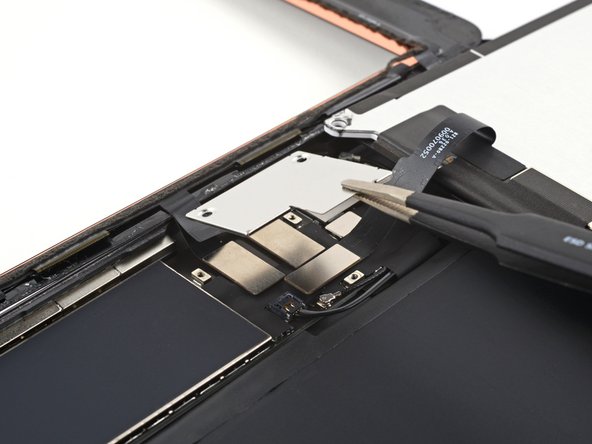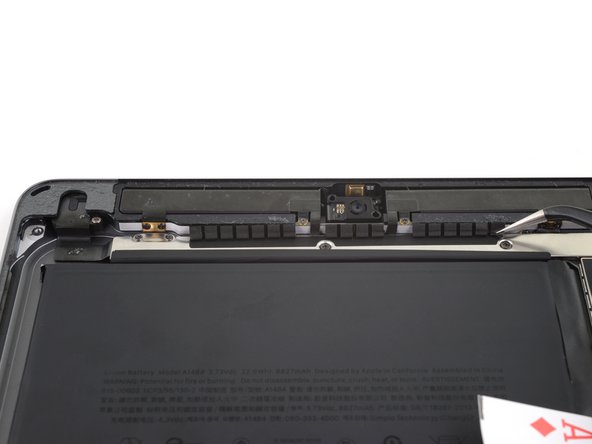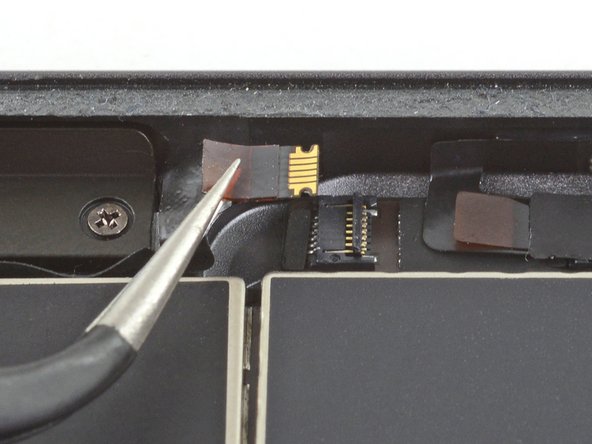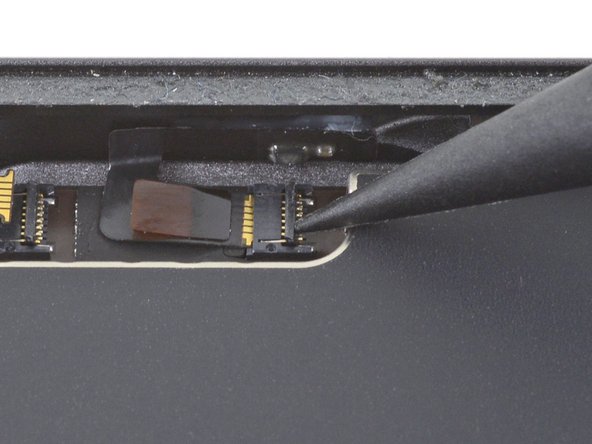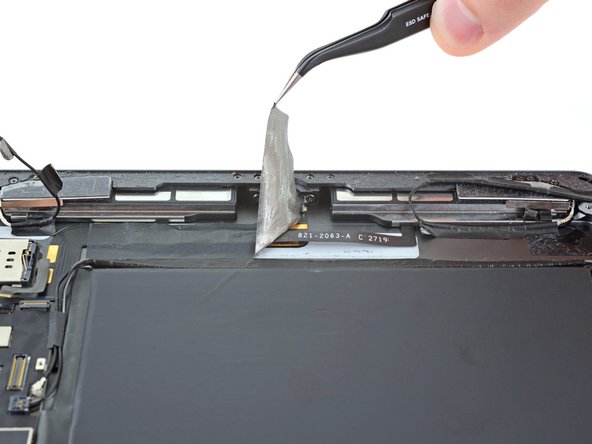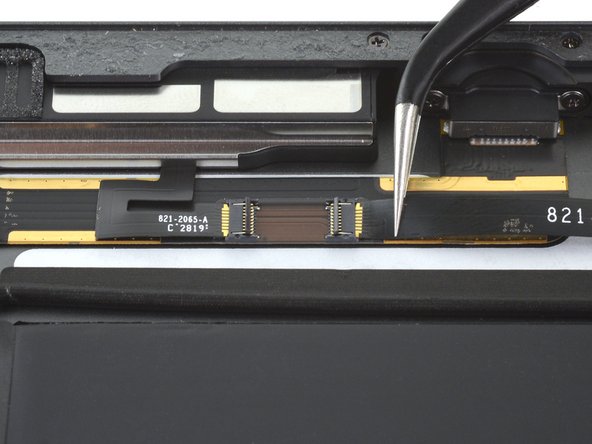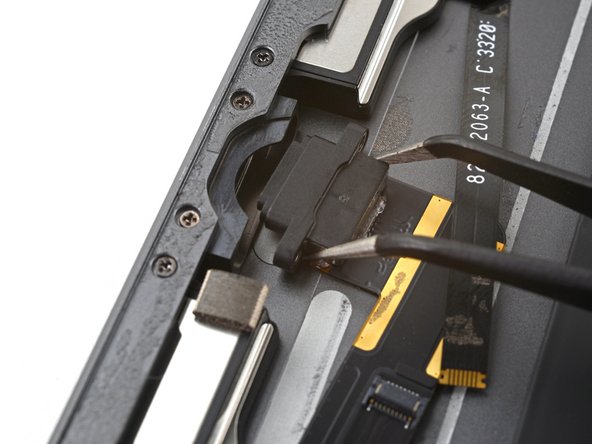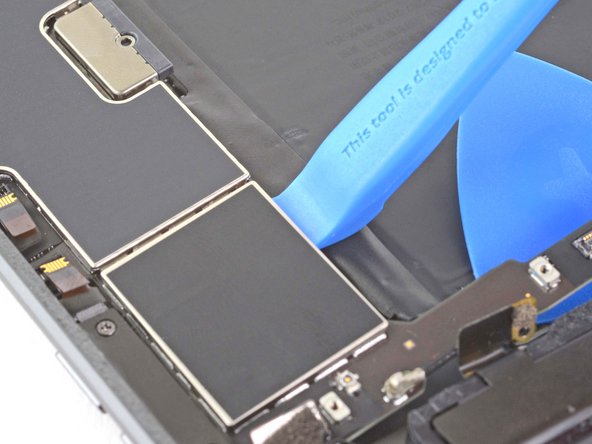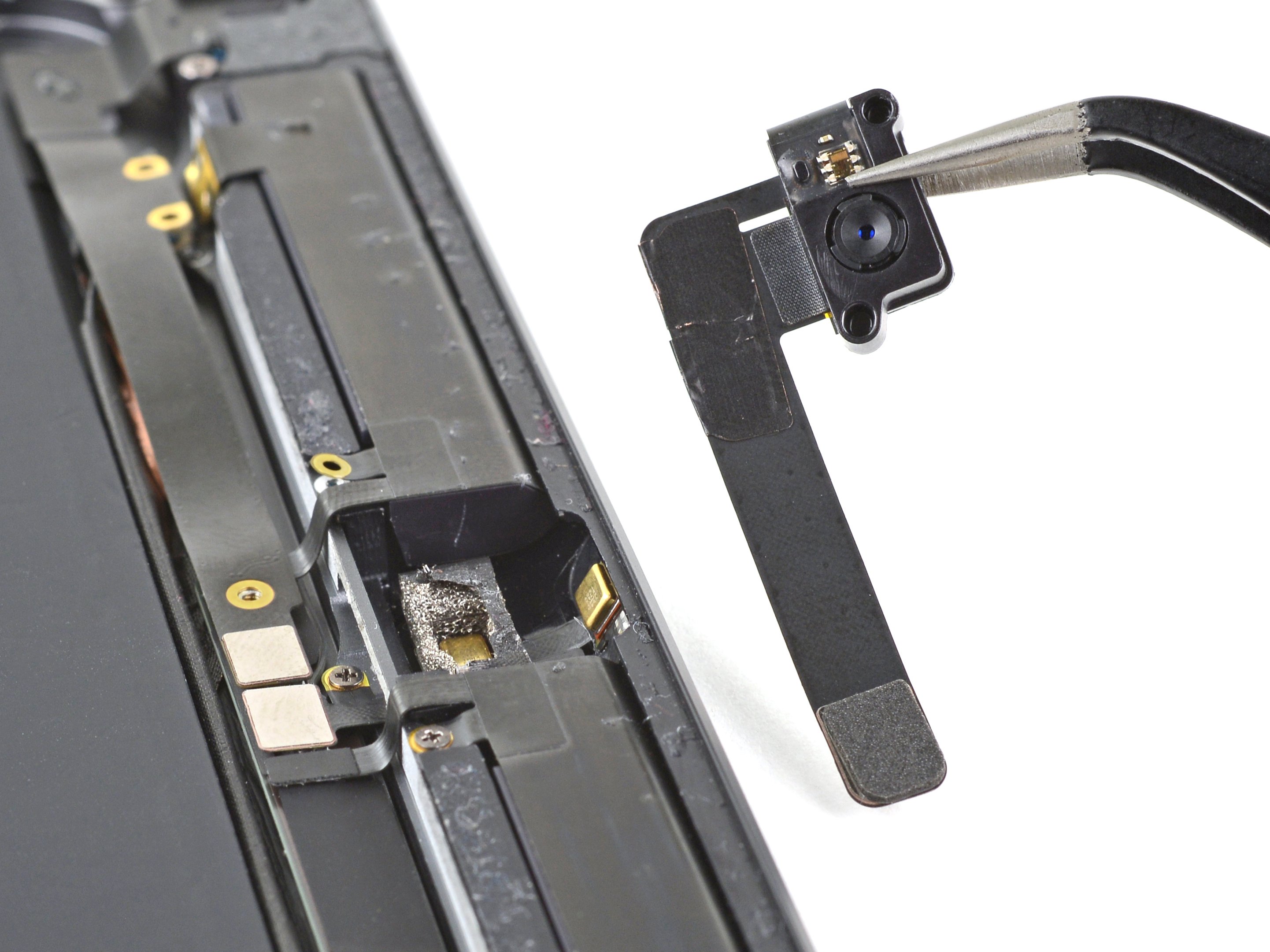iPad 8 LTE Battery Replacement
Duration: 45 minutes
Steps: 119 Steps
Before diving in, make sure to drain your iPad's battery to below 25%. It's just a good safety move to avoid any surprises while you're at it.
Ready to swap out the battery in your iPad 8 LTE? Let’s get started! Quick heads-up: this guide is only for the LTE version, so if you’ve got the Wi-Fi version, click here. Before diving in, make sure your battery is under 25% to keep things safe. This lowers the risk of a fire in case something goes wrong during the repair. If your battery is looking a little swollen, take extra care. When using a battery blocker to isolate the battery, be gentle—the contacts are fragile and could easily break or bend, leading to permanent damage. If you skip the isolation step (not recommended, but hey, it’s your call), try not to use metal tools unless it’s absolutely necessary (like for screw removal) to avoid shorting the battery or damaging delicate components. Some of the images in this guide are from a different model, so there may be slight differences, but don’t worry—they won’t mess with the procedure.
Step 1
- Warm up your iOpener and let it cozy up to the left edge of the device for two minutes.
Tools Used
Step 2
- While waiting for the adhesive to loosen up, keep an eye on these sensitive areas that might give you some trouble if you get too rough with them:
- Front camera
- Antennas
- Display cables
Step 3
Hey, the next three steps show off our Anti-Clamp tool, which makes cracking this open a whole lot easier. If you're not using it, just hop ahead three steps for another approach.
For the full rundown on using the Anti-Clamp, check out this guide.
If the iPad's surface feels too slick for the Anti-Clamp to get a grip, use tape to make it stickier.
- Give that blue handle a gentle pull backwards to unlock the Anti-Clamp's arms.
- Slip something under your iPad to keep it resting nice and level between the suction cups.
- Position the suction cups around the middle of the left edge—one up top, one down below.
- Hold the bottom of the Anti-Clamp steady, then firmly press down on the top cup to get it sucking.
Step 4
- Slide the blue handle forward to lock the arms in place.
- Rotate the handle clockwise a full 360 degrees or until you notice the cups beginning to stretch.
- Keep an eye on the suction cups to make sure they stay lined up. If they start to drift, gently loosen the suction cups and adjust the arms until they’re back in sync.
Step 5
Take it easy—don’t twist more than half a turn at a time. Give it a minute to breathe between each turn. Let the Anti-Clamp and time do the heavy lifting for you!
For the full rundown on using a hair dryer, check out this guide.
If the Anti-Clamp isn't making enough room, add a little more heat and give the handle a half-turn clockwise.
- Hang tight for a minute to let that adhesive loosen up and create a nice opening gap.
- If your screen's not heating up enough, grab a hair dryer and gently warm along the left edge of the iPad.
- Slide an opening pick under the digitizer once the Anti-Clamp has made a big enough space.
- You can skip the next step here.
Step 6
If your screen's got some serious cracks, try slapping on some clear packing tape to help that suction cup stick. Or swap in some heavy-duty tape as a backup for the suction cup. When push comes to shove, a dab of superglue on the suction cup could do the trick on that busted screen.
- When the screen feels nice and warm to the touch, grab your suction handle and place it on the left edge of the screen, right up close to the side.
- Gently lift the screen using the suction handle to create a small gap between the digitizer and the frame.
- Slide an opening pick into that gap between the digitizer and the frame.
Tools Used
Step 7
If you spot the opening pick peeking through the digitizer, no sweat—just slide it out gently. The LCD is safe and sound, but be careful not to leave any sticky residue behind that’s a pain to clean up later.
- Slip in that second opening pick right into the gap you just made – nice and smooth!
- Gently slide the pick down toward the bottom-left corner to loosen up that stubborn adhesive.
- Park the pick there in the bottom-left corner to keep the adhesive from sticking back together.
Step 8
- If the opening pick gets stuck in the adhesive, just roll it along the side of the iPad to keep peeling away that stubborn adhesive.
Step 9
- Gently slide the first opening pick towards the top-left corner of your device to break free that stubborn adhesive.
- Leave the pick snugly in the top-left corner to keep the adhesive from sticking back together. We've got this!
Step 10
- Grab your iOpener, heat it up, and cozy it onto the top edge of the device for two minutes.
Tools Used
Step 11
- Give that pick a gentle spin around the top-left corner to loosen up the adhesive – nice work!
Step 12
Hey, steer clear of sliding that pick over the front camera—you might nick the lens! No sweat, the next steps will help you dodge it like a pro.
- Gently slide the opening pick along the top edge of the device, and pause just before you hit the front camera—almost there!
Step 13
- Gently pull the pick until only the tip is nestled between the digitizer and the frame. It’s like giving your device a little stretch!
- Now, slide the pick just above the front camera. You’ll feel the adhesive give way. It's like peeling back a sticker but cooler!
- Leave the pick right by the right side of the front camera for now. You’ll want it there before moving on. Stay steady, you're almost there!
Step 14
- Gently slide the pick towards the top-right corner of your device to break that sticky bond completely.
- Keep the pick in place at the top-right corner to make sure the adhesive doesn't get any ideas about re-sealing.
Step 15
- Warm up your iOpener and apply it to the right edge of the device for two minutes—nice and steady!
Tools Used
Step 16
- Gently twist the pick around the top-right corner of the device to loosen the adhesive.
Step 17
The display cables are nestled around the halfway mark from the bottom of the iPad. Slide carefully, but stop once you're about three inches away from the bottom. No need to push it further!
- Grab a fresh opening pick and glide it right to the center of that iPad's right edge.
Step 18
- Warm up an iOpener and place it on the bottom edge of the device for two minutes.
Tools Used
Step 19
Be careful not to spin the pick all the way around the corner – you might accidentally mess with the antenna.
- Gently slide the pick into the bottom-left corner to break through the adhesive. Take it slow, it’ll give you a clean start!
- Once the pick is in place, just leave it there and move on to the next step. You’re on the right track!
Step 20
Remember, slide the pick toward the home button, not away from it! You don’t want to mess with the antenna and cause some unwanted drama. Stay focused!
If you need to slide the pick over this section again, just remove it and reinsert it starting from the bottom-left corner. It's a little trick, but it works like a charm!
- Grab your new opening pick and slide it into the gap you made on the bottom edge of your iPad.
- Gently glide the pick over the antenna, but stop just before reaching the home button.
- Make sure to leave the pick just to the left of the home button before you move on. Easy, right?
Step 21
Slide the pick in no more than 1 mm to keep that right antenna safe and sound.
- Take your opening pick and gently slide it into the gap you've made.
- Now, work the pick underneath the home button, easing it toward the bottom-right corner. Just make sure the tip stays between the digitizer and the frame — don't push too hard!
Step 22
Slide the pick towards the home button—avoid going the other way to steer clear of antenna damage.
If you need to slide the pick over this section again, just remove it and re-insert at the bottom-right corner.
- Grab the pick again and gently slide it towards the home button to completely free the bottom adhesive. It’s like unwrapping a gift—just smooth and steady.
- Now, leave the pick resting just to the right of the home button, and you’re all set to move on to the next step!
Step 23
- Warm up that iOpener and gently press it against the right edge of your device for two minutes – let's loosen things up nicely!
Tools Used
Step 24
Take it easy with this step—patience is your best friend here. Make sure the adhesive is nice and warm, so it’s soft and easy to work with. Carefully slide your pick along to separate all the adhesive. And hey, if things get tricky, don’t hesitate to pause and heat it up again.
If you're hitting some serious resistance, just give those edges a quick reheat and slide your opening pick along them like a pro.
- Give those two opening picks a gentle twist at the left corners of your iPad to nudge the digitizer up just a bit, breaking free the last of that stubborn adhesive.
Step 25
- Gently lift the left side of the digitizer up to peel back more of that adhesive on the right edge of the iPad.
Step 26
- Hold the digitizer steady and slide your opening pick between those two display cables to peel off that last stubborn adhesive.
Step 27
- After you've carefully loosened all the adhesive, open the digitizer like a book and let it chill parallel to the iPad.
- When putting everything back together, wipe away any leftover adhesive from the frame—and the digitizer if you're reusing it—using some isopropyl alcohol. Then, pop on fresh adhesive strips or pre-cut adhesive cards to keep things snug.
- Keep a close eye on those display cables as you reassemble. Make sure they’re neatly folded under the LCD screen to avoid any accidental damage.
Step 28
- Grab some tweezers or use your fingers to peel away any tape hiding those LCD screws.
Tools Used
Step 29
- Grab your Phillips screwdriver and loosen those four 4.3 mm screws holding the LCD screen in place—easy does it!
Step 30
The LCD is gently attached to the frame with a light adhesive.
- Slide a spudger between the frame and the top-right part of the LCD.
- Pry gently with the spudger to break free from that adhesive.
Tools Used
Step 31
- Do the same thing you just did, but this time tackle the top-left corner of the LCD. You got this!
Step 32
Hold up—don't pull the LCD all the way out yet, it's still attached by that flex cable.
- Grab your spudger and use its flat end to gently pry the LCD out of its recess—just enough to get a good finger grip.
- Flip the LCD like turning a page in a book, lifting near the camera and swinging it over to the home button end of the frame.
- Lay the LCD on a clean, soft, lint-free surface to make those display cables easy to access.
Tools Used
Step 33
- Grab your Phillips screwdriver and carefully remove that 2.3 mm screw securing the battery connector to the logic board.
Step 34
Check out these shots to see what the battery connector looks like tucked under the logic board. Use them as your go-to guide when carefully disconnecting the battery.
Heads up: the battery connector has cantilever springs on the logic board that press against the battery's contact pads. Since both the board and battery are glued down, you'll want to gently slide something thin and bendy between the contacts to safely pop the battery loose.
Step 35
Take it easy when disconnecting the battery with a battery blocker. Those contacts can bend or snap super easily, leading to permanent damage.
Make sure the logo on the battery blocker is facing up for that perfect fit.
Take it easy when sliding the battery blocker under the connector—don't force it. If it's not cooperating, swap in a playing card to disconnect the battery smoothly.
The blocker or card should glide right under the logic board without hitches, sitting at a comfy 15-degree angle once it's in place.
- Gently slide the battery blocker under the logic board's battery connector at a 35-degree angle.
- Keep that battery blocker in place as you keep working.
Tools Used
Step 36
- Grab your Phillips screwdriver and twist out those three 1.4 mm-long screws holding the display cable bracket.
Step 37
- Grab your tweezers or use your fingers to carefully remove the display cable bracket.
Tools Used
Step 38
- Grab the flat edge of your spudger and gently lift to unplug the LCD cable's press connector.
- When it's time to snap it back on, line it up just right and press down on one side until you hear that satisfying click, then do the same on the other side.
- Steer clear of pressing right in the middle—trust us, a misaligned connector can bend those pins and lead to lasting trouble.
Tools Used
Step 39
- Gently take that LCD all the way out and set it face down on a clean, soft, lint-free spot.
Step 40
- Grab a pair of tweezers and carefully peel off the tape that's protecting the home button cable ZIF connector. Easy does it!
Tools Used
Step 41
- Hey there, grab a spudger, opening tool, or even your fingernail to gently flip up that small hinged locking flap on the home button cable's ZIF connector.
Tools Used
Step 42
- Grab your tweezers and gently pull the home button ribbon cable straight out of the ZIF connector like a pro.
Tools Used
Step 43
Careful now, buddy—pry only on the connectors to keep your iPad from getting banged up, not the socket on the logic board.
- Hey, grab the flat end of your spudger and gently pry up to disconnect those two digitizer cable press connectors.
Tools Used
Step 44
Be gentle with that home button ribbon cable—let's keep it intact without any pokes or tears.
- Grab the flat end of your spudger and carefully lift up the vibration isolator sitting just below the SIM card reader—take it nice and slow!
- Now, simply pull out that vibration isolator and set it aside.
Tools Used
Step 45
The cable is held down with a bit of gentle adhesive.
- Use a pair of tweezers to peel the home button cable away from the rear case.
Tools Used
Step 46
Grab an opening pick and carefully slice through any sticky adhesive still holding the front panel assembly to the frame—think of it as gently breaking up an old friendship between glue and glass.
If the digitizer areas aren’t properly insulated, they might throw a tantrum by grounding against other parts, messing up your touch input.
This insulation is a sneaky little helper—completely invisible to your eyes and not the same as the foam dust barriers you’ve seen on many iPads.
- Remove the front panel assembly.
- If you experience "ghost" or "phantom" touch input issues with your new display, this can be resolved by adding a layer of very thin insulating tape, such as Kapton (polyimide) tape , to the highlighted areas on the back of the panel. iFixit replacement digitizers come with the proper insulation and should not require the addition of any tape.
- During reassembly, before installing a display, remove any remaining adhesive from the iPad, and clean the glued areas with high concentration isopropyl alcohol (90% or greater) and a lint-free cloth. This helps prep the iPad for fresh adhesive and ensures that it will bond properly.
- Test your iPad's functions and install pre-cut adhesive strips to the back of the display using our display adhesive application guide before sealing it up.
Step 47
- Grab a SIM eject tool, a bit, or a straightened paper clip and slide it into the SIM card tray hole.
- Give it a firm push to eject the SIM card tray.
Step 48
- Take out the SIM card tray from your iPad. A little tug, and it's free! Need a hand? You can always schedule a repair.
Step 49
- Hey, take it easy and gently lift that LCD buffer tape off the upper component bracket with care.
Step 50
- Grab your trusty Phillips screwdriver and unscrew the five screws holding that upper component bracket in place.
- Three screws that are 1.4 mm long—super tiny but important!
- Two screws that are 1.9 mm long—don't let them sneak away!
Step 51
Hey, you might need to gently peel that upper component bracket off the tape holding it to the logic board.
- Grab your trusty spudger and use the pointed end to carefully lift up the upper component bracket—just enough so you can get a good grip with your fingers.
- Now that you’ve got it, gently remove the upper component bracket.
Tools Used
Step 52
- Hey, grab your spudger with the flat end and gently pry up that front camera cable press connector to disconnect it.
Tools Used
Step 53
- Grab your spudger and gently lift the front camera from its spot until you can snag it with your fingers—easy peasy!
- With that same spudger, peel away the sticky foam pad clinging to the front camera, nice and smooth.
Tools Used
Step 54
- Grab a pair of tweezers and gently grip the front camera. Twist it clockwise to guide the cable through its designated slot in the frame.
- Now, carefully remove the front camera.
Tools Used
Step 55
- Gently pry up the headphone jack connector using the flat end of a spudger, lifting it straight off the press connector. Take it slow, you got this!
Tools Used
Step 56
- Grab your tweezers and gently peel the headphone jack up from the logic board, then reposition the cable.
Tools Used
Step 57
- Grab a Phillips screwdriver and remove those three 1.4 mm screws that are holding the cellular antennas onto the rear case.
Step 58
- Grab the pointed end of your spudger and carefully pry up the right cellular antenna coaxial cable as close to the connector as you can—easy does it to get it disconnected.
- Now, let's disconnect that left antenna cable and keep the momentum going.
Tools Used
Step 59
Hey, grab that antenna cable right by the cable itself, not the connector—pulling on those coaxial connectors can snap 'em right off!
- Gently peel the left cellular antenna coaxial cable away from the rear case.
Step 60
- Grab the flat end of your spudger and gently lift both cellular antennas straight up to disconnect them from their press connectors – smooth sailing!
Tools Used
Step 61
- Grab your spudger's flat end and give the rear camera connector a gentle lift straight up to disconnect it—smooth sailing!
Tools Used
Step 62
- Grab the flat end of your spudger and gently lift that microphone connector straight up to disconnect it – you're doing great!
Tools Used
Step 63
- Let's peel off that tape covering the button control cable's ZIF connector – nice and easy!
Step 64
- Grab the tip of a spudger, opening tool, or even your fingernail to gently flip up that small, hinged locking flap on the button control cable's ZIF connector.
Tools Used
Step 65
Hold onto that pull tab on the cable—don't grab the cable itself!
- Gently grab the button control cable with a pair of tweezers and give it a smooth, steady pull to release it from the ZIF connector. Nice and easy – no rush!
Tools Used
Step 66
- Carefully peel away any tape that’s hiding the Smart Cover sensor cable ZIF connector. Easy does it!
Step 67
- Grab your spudger, an opening tool, or just your trusty fingernail, and gently lift up the small locking flap on the Smart Cover sensor cable ZIF connector. You’ve got this!
Tools Used
Step 68
Snag the cable by its pull tab—don't grab the cable itself!
- Gently grab the Smart Cover sensor cable with a pair of tweezers and pull it straight out of the ZIF connector.
Tools Used
Step 69
- Gently use the tip of a spudger, an opening tool, or even your fingernail to flip up the tiny hinged locking flap on the SIM card reader cable ZIF connector. Take it slow and steady!
Tools Used
Step 70
- Grab some tweezers and gently slide that SIM card reader cable straight out of the ZIF connector.
Tools Used
Step 71
- Grab your spudger and slide its pointed end under the right antenna cable, then lift it straight up to disconnect it like a pro—easy peasy!
Tools Used
Step 72
Hold that antenna cable by the cable itself, not the connector—yanking on connectors is a quick way to break 'em!
- Gently lift the right antenna cable to get it ready for the next step.
Step 73
- Gently slide the pointed tip of your spudger under the left antenna cable and lift it straight up to disconnect it. Nice and easy!
Tools Used
Step 74
- Gently peel the left antenna cable away from the rear case, along the bottom edge of the iPad. Keep it smooth and steady!
Step 76
- Grab a pair of tweezers or even your fingernail to carefully peel back the tape hiding the speaker connectors.
Tools Used
Step 77
- Grab a spudger, an opening tool, or even your fingernail and gently lift up the little locking flap on both the left and right speaker cable ZIF connectors. It’s a quick move, just be careful not to force anything!
Tools Used
Step 78
- Grab a pair of tweezers and gently pull the left and right speaker cables straight out from their ZIF connectors. Take it slow and steady, you've got this!
Tools Used
Step 79
- Grab the pointed end of your spudger and gently pry up the Smart Connector coaxial cable right next to the connector to disconnect it without any fuss.
Tools Used
Step 80
- Grab your tweezers and gently lift the Smart Connector cable connector straight up to disconnect it.
Tools Used
Step 81
- Grab your tweezers and gently peel back the tape holding the Smart Connector cables to the rear case.
Tools Used
Step 82
- Gently peel the Smart Connector cables away from the rear case.
Step 83
- Warm up your iOpener and gently apply it to the bottom left corner of the rear case to loosen the SIM card tray adhesive for about 30 seconds.
Tools Used
Step 84
If that SIM card reader is feeling stubborn, just add a little more heat and give it another shot!
- Grab your opening tool and gently pry up the bottom edge of the SIM card reader with steady, even pressure – nice and easy does it!
Step 85
- Pop out that SIM card reader – easy does it!
Step 86
- Grab your Phillips screwdriver and remove the four screws holding the charging port in place:
- Two of them are 2.2 mm long
- And the other two are 3.2 mm
Step 87
- Warm up your iOpener and gently apply it to the bottom, top, and logic board side of the iPad, holding for 30 seconds on each spot.
Tools Used
Step 88
- Grab your opening pick and slip it under the charging port cable right near the port. Slide it toward the logic board to cut through the adhesive.
Step 89
- Gently lift the charging port out from its snug spot in the frame.
Step 90
- Slide an opening pick under the upper arm of the logic board and glide it toward the logic board to slice through the adhesive holding it to the back case.
- Keep that opening pick in place to prevent the adhesive from sticking back.
Step 91
- Take off the battery blocker – it's like unlocking the power to your device! 💥
Tools Used
Step 92
Be careful not to bend or twist the logic board—doing so could cause some serious, lasting damage. If the adhesive is being stubborn, try applying a little more heat and give it another go. You’ve got this!
Gently slide an opening pick under the bottom edge of the logic board to slice through any stubborn adhesive if the board is resisting your efforts to move.
- Gently slide an opening tool under the bottom of the logic board and give it a little nudge. Apply even, steady pressure to slowly lift it away from the rear case. Patience is key!
Step 93
Watch out when using the tool near the battery—puncturing or bending it could release harmful chemicals or start a fire. Stay safe out there!
- Grab an opening tool and position it near the middle of the logic board, then apply a slow and steady pressure to gently lift it away from the rear case.
Step 94
- Slide your opening tool near the top of the logic board and pry up steadily to lift it off the rear case.
Step 95
- Place an opening tool gently in the middle of the logic board. Pry it up slowly until you're able to grab it with your fingers. Take your time and be gentle!
Step 96
- Grab your halberd spudger or opening pick and carefully slice through any stubborn adhesive holding the logic board to the frame. Take your time—this part can be a bit sticky, but you've got this!
Tools Used
Step 97
- Start by carefully removing the logic board. Take your time, and don't rush through it.
- As you’re putting everything back together, make sure no pesky ribbon cables are trapped under the logic board. We don’t want any surprises when you glue it down!
- When it's time to reassemble, give the surface a quick clean to remove any leftover adhesive. Just grab some high-strength isopropyl alcohol (90% or higher) and wipe it clean. Then, use strips of Tesa tape to hold the logic board in place, ensuring it sticks securely to the chassis.
Step 98
Before you get that battery out, make sure to cover the other parts in the back case with tape to keep everything safe and sound.
Run your finger along the tape's bottom edge to make sure it's sealed tightly. You don’t want any surprises later!
- Grab a strip of painter's tape or Scotch tape—just enough to match the width of your iPad.
- Stick the bottom edge of the tape right above the speakers and bottom antennas on the rear case. Make sure it's nice and snug.
- Now, press the top edge of the tape gently over the bottom components. This keeps any cables out of the way during the battery removal process.
Step 99
- Go ahead and tape up those upper parts just like you did before—keep that secure vibe going!
Step 100
Hey, just a heads up—the adhesive remover has acetone, which can be a mild irritant for your skin and eyes.
- Time to protect those peepers! Make sure to wear eye protection while dealing with adhesive remover.
- If you're rocking contact lenses, don't forget the eye protection—better safe than sorry!
- Your kit has included protective gloves, just in case your skin's a little sensitive. If you're concerned, pop those gloves on now for extra peace of mind.
Tools Used
Step 101
Twist the bottle cap to loosen it up before trimming the applicator tip.
Twist and secure the bottle cap tightly before moving to the next step.
This unseals the bottle and lets the pressure even out before you trim the applicator tip. Skip this, and the adhesive remover could surprise you by spraying out when you cut—good idea to avoid that drama!
Trimming close to the narrow end gives you better control, letting you apply the adhesive remover in tiny, precise doses.
- Pop off the black rubber stopper from the adhesive remover bottle—it's time to get that sticky stuff off!
- Grab a pair of scissors and snip off the sealed tip of the applicator. Now you're ready to apply!
Step 102
- Spot those red boxes—they're highlighting where the adhesive strips are keeping the battery glued to the rear case.
Step 103
- Dribble a few drops of adhesive remover or high-concentration isopropyl alcohol along the left edge of the battery to loosen things up nicely.
Step 104
- Dribble a few drops of adhesive remover or high-strength isopropyl alcohol along the bottom edge of the battery.
Step 105
- Dab a few drops of adhesive remover or high-concentration isopropyl alcohol right between those two battery cells – you've got this!
Step 106
- Gently drip a few drops of adhesive remover or some strong isopropyl alcohol along the right edge of the battery.
Step 107
- Drip a few drops of adhesive remover or high-strength isopropyl alcohol along the top edge of the battery to get things moving.
Step 108
Watch out not to poke or bend that battery with your tool—it could leak some nasty chemicals or spark a hot mess.
If you're struggling to loosen that battery, just add a splash more adhesive remover or give the back case a warm hug with a heated iOpener.
- Slide a plastic card in at the bottom right corner of the battery to get things moving.
Tools Used
Step 109
- Gently slide the plastic card under the right edge, heading straight for the center.
- Push the card in as deep as possible under the battery to slice through that adhesive.
- Pull the plastic card out now.
Step 110
- Slide that plastic card under the battery connector as far as it can go.
- Keep the plastic card right where it is.
Step 111
- Slide a plastic card gently above the battery connector, pushing it as deep as you can. This'll help you separate things without causing a mess!
Step 112
- Slide that handy plastic card from below the battery connector and tuck it neatly under the bottom edge of the battery.
Step 113
- Glide your plastic card along the battery's bottom edge to slice through that adhesive strip.
- Once you hit the left corner at the bottom, push the plastic card in as deep as it goes.
Step 114
If the battery's being stubborn, slather on a bit more adhesive remover or warm up the back case with a heated iOpener.
- Gently remove the plastic card from above the battery connector and slide it carefully under the top edge of the battery.
- Now, glide the card along the top edge of the battery to separate the adhesive strip. It’ll give way with just a little nudge!
Tools Used
Step 115
- When you get to the upper left corner, gently slide that plastic card in as far as it’ll go—give it a little wiggle if needed, but be kind to your device. You're almost there!
Step 116
- Slip that plastic card right under the upper left corner of the battery—nice and easy.
- Slide it smoothly down toward the bottom of your iPad.
- When you hit the center edge of the battery, push the card in as far as you can to cut through that central adhesive strip.
Step 117
- Gently insert the plastic card under the bottom left corner of the battery.
- Smoothly slide the plastic card up towards the top of the iPad.
Step 118
- Once you hit the center edge, slide the plastic card in as far as it goes to slice through the central adhesive strip.
Step 119
Don't even think about using that old battery once it's been removed! It's a safety risk, and we definitely don't want that. Grab a fresh, new battery and keep things running smoothly!
Still stuck on removing the battery? No worries! Just go ahead and repeat the process of slicing through that battery adhesive again. You've got this!
- To put your device back together, just follow these steps in reverse.
- For the best results with that fresh battery, calibrate it once you're all done.
- Do the planet a solid by recycling your old e-waste at an R2 or e-Stewards certified spot.
- Didn't go smoothly? Try some basic troubleshooting, or if you need help, you can always schedule a repair.
-
































































































